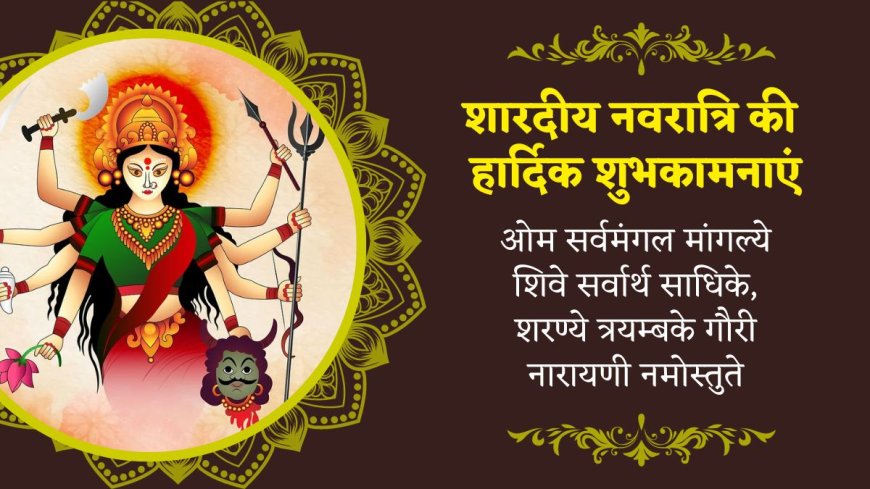Navratri 2023 Kalash Sthapna, Puja Vidhi and Kanya Puja.

Navratri 2023 Kalash Sthapna :
Shardiya Navratri, also known as Maha Navratri, is the most celebrated and widely observed Navratri festival. It falls in the Hindu month of Ashwin (usually in September or October) and typically lasts for nine nights and ten days. Shardiya Navratri is dedicated to the worship of the goddess Durga.
Navratri 2023 starts from 15 th October, Sunday and ends on 23 rd October Monday. Kalash Sthapana Subh Muhurat is starting from 15th October 11:09 am to 11:56 am.
During Navratri, people observe fasts, perform religious rituals, participate in traditional dances like Garba and Dandiya, and celebrate the victory of good over evil.
Puja Samagri for Kalash Sthapana
The items required for performing the puja (worship) during Shardiya Navratri can vary depending on your family or community traditions. Here is a list of common puja samagri (worship materials) that are often used during Navratri:
1. Murti or Idol of Goddess Durga: This is the central focus of the puja. You can either use a small idol or a picture of Goddess Durga.
2. Akshat (Raw Unbroken Rice): Used for offering to the goddess.
3. Flowers: Fresh flowers, especially marigolds, are commonly used as offerings.
4. Incense Sticks (Agarbatti) and Dhoop: Used for creating a fragrant atmosphere during the puja.
5. Diya or Oil Lamp: Lit to symbolize the removal of darkness and ignorance.
6. Camphor (Kapoor): Used for Aarti (waving of the lamp).
7. Coconut: Offered as a symbol of purity.
8. Sweets and Fruits: Typically offered to the goddess and then distributed as Prasad.
9. Kumkum (Vermilion) and Haldi (Turmeric Powder): Used for applying a tilak (mark) on the idol and for decoration.
10. Sandalwood Paste: Often used for applying tilak on the idol.
11. Chana (Chickpeas) and Jaggery: These are common offerings to the goddess.
12. Kalash: A pot filled with water and covered with mango leaves is often used as a symbol of abundance and purity.
13. Aarti Thali: A plate or tray used to hold the items for Aarti, including a small lamp or diya.
14. Red Cloth: Used for covering the altar or murti.
15. Bell: Often rung during the puja to ward off negative energies.
16. Coconut and Betel Leaves: Offered during the Aarti.
17. Durga Saptashati Book: If you're reciting the Durga Saptashati, you'll need a copy of the text.
18. Sacred Water: Ganga jal (water from the Ganges river) or simply clean, purified water.
19. Roli and Chawal: Red vermillion and rice grains for applying tilak.
20. Moli or Red Thread: Used for tying on the wrist as a protective thread.
How to Celebrate Navratri :
Celebrating Shardiya Navratri involves various customs, rituals, and practices. Here's a general overview of how to celebrate and participate in the festival:
-
Preparation:
- Begin preparations for the festival well in advance by cleaning and decorating your home. Many people also build a small temple or shrine dedicated to the goddess Durga in their homes.
- Purchase or make traditional clothing, such as chaniya cholis or ghagra cholis for women and kurtas or dhotis for men.
-
Fasting and Diet:
- Many people choose to fast during Navratri, abstaining from certain foods and consuming only satvik (pure) vegetarian meals.
- Common foods consumed during fasting include fruits, nuts, dairy products, and specific grains like amaranth and buckwheat.
- It's essential to consult with a nutritionist or healthcare professional before starting a fast, especially if you have specific dietary needs or health concerns.
-
Prayers and Puja:
- Perform daily prayers and rituals dedicated to the goddess Durga. This typically includes lighting a lamp or diya, offering flowers, incense, and fruits, and reciting prayers and mantras.
- The Durga Saptashati, a set of hymns and stories about the goddess, is often recited during Navratri.
-
Visit Temples:
- Many people visit temples, especially those dedicated to Durga, during Navratri. Temples often hold special ceremonies and events during this time.
-
Garba and Dandiya Raas:
- Participate in the traditional folk dances of Garba and Dandiya Raas, which are an integral part of Navratri celebrations in many regions. These dances are performed in groups and involve rhythmic footwork and the use of sticks (Dandiya).
-
Observing Navami and Dashami:
- The ninth day (Navami) and tenth day (Dashami) of Navratri are significant. On Navami, young girls are often invited to homes, served food, and given gifts as a symbol of the goddess's blessings.
- On Dashami, a special prayer ceremony is performed to bid farewell to the goddess Durga. In some regions, clay idols of the goddess are immersed in water.
-
Community Celebrations:
- Many communities organize large-scale Navratri events with cultural programs, music, dance, and delicious food.
-
Cultural Activities:
- Immerse yourself in the cultural aspects of Navratri, including traditional music, art, and clothing.
Nine Forms of Goddess Durga with Mantras :
In Hinduism, the nine forms of the Goddess Durga that are worshipped during Navratri are known as the Navadurga. Each of these forms represents a different aspect of the divine feminine energy. Here are the nine forms of Navadurga along with their associated mantras:
-
Shailaputri (Daughter of the Mountain):
- Mantra: "ॐ देवी शैलपुत्र्यै नमः" (Om Devi Shailaputryai Namah)
- She is often depicted riding a bull and is associated with the color gray.
-
Brahmacharini (The Ascetic Goddess):
- Mantra: "ॐ देवी ब्रह्मचारिण्यै नमः" (Om Devi Brahmacharinyai Namah)
- She is depicted as a female ascetic and is associated with the color blue.
-
Chandraghanta (The Goddess with a Half-Moon Shaped Bell):
- Mantra: "ॐ देवी चंद्रघंटायै नमः" (Om Devi Chandraghantayai Namah)
- She is depicted with a moon-shaped bell on her forehead and is associated with the color orange.
-
Kushmanda (The Creator of the Universe):
- Mantra: "ॐ देवी कूष्माण्डायै नमः" (Om Devi Kushmandayai Namah)
- She is often depicted as seated on a lion and is associated with the color green.
-
Skandamata (The Mother of Skanda/Kartikeya):
- Mantra: "ॐ देवी स्कन्दमात्र्यै नमः" (Om Devi Skandamatryai Namah)
- She is depicted with her son Skanda in her lap and is associated with the color gray.
-
Katyayani (The Warrior Goddess):
- Mantra: "ॐ देवी कात्यायन्यै नमः" (Om Devi Katyayanayai Namah)
- She is often depicted as a fierce warrior and is associated with the color red.
-
Kaalratri (The Dark Goddess):
- Mantra: "ॐ देवी कालरात्र्यै नमः" (Om Devi Kalratryai Namah)
- She is depicted as dark and fierce, riding a donkey, and is associated with the color black.
-
Maha Gauri (The Great White Goddess):
- Mantra: "ॐ देवी महागौर्यै नमः" (Om Devi Mahagauriyai Namah)
- She is depicted as fair and is associated with the color white.
-
Siddhidatri (The Goddess of Supernatural Powers):
- Mantra: "ॐ देवी सिद्धिदात्र्यै नमः" (Om Devi Siddhidatriyai Namah)
- She is often depicted with supernatural or divine powers and is associated with the color red.
Kanya Puja in Navratri :
Kanya Puja, also known as Kanjak Puja or Kumari Puja, is a significant ritual during Navratri, especially on the eighth or ninth day (Ashtami or Navami) of the festival. During this puja, young girls, typically aged between 2 and 10 years, are worshipped as the living embodiments of the Goddess Durga. Kanya Puja is performed to honor the divine feminine energy and is considered highly auspicious.
Here's how Kanya Puja is traditionally performed:
1. Inviting Young Girls:
- Devotees invite a group of young girls, usually numbering 7, 9, or 11, to their home or a temple.
- These girls are considered the physical manifestations of the nine forms of Goddess Durga.
2. Preparation:
- A clean and beautifully decorated altar is set up for the puja, usually with images or idols of the Goddess Durga.
- Offerings like fruits, sweets, flowers, and small gifts are prepared for the young girls.
3. Washing Feet:
- Before the puja begins, the feet of the young girls are washed to symbolize the purity of the goddess.
4. Offering Puja:
- The girls are then seated in a row, and a priest or a family member performs the puja rituals.
- The rituals typically involve lighting a diya (oil lamp), applying tilak (vermillion), tying moli (red thread), and offering flowers and prasad (sacred food).
5. Feeding and Gifts:
- After the puja, the young girls are offered a sumptuous meal that often includes puri, chana, halwa, and kheer.
- They are also given small gifts or tokens of appreciation.
6. Seeking Blessings:
- Devotees touch the feet of the young girls and seek their blessings, considering them as representatives of the divine goddess.
What's Your Reaction?





















































